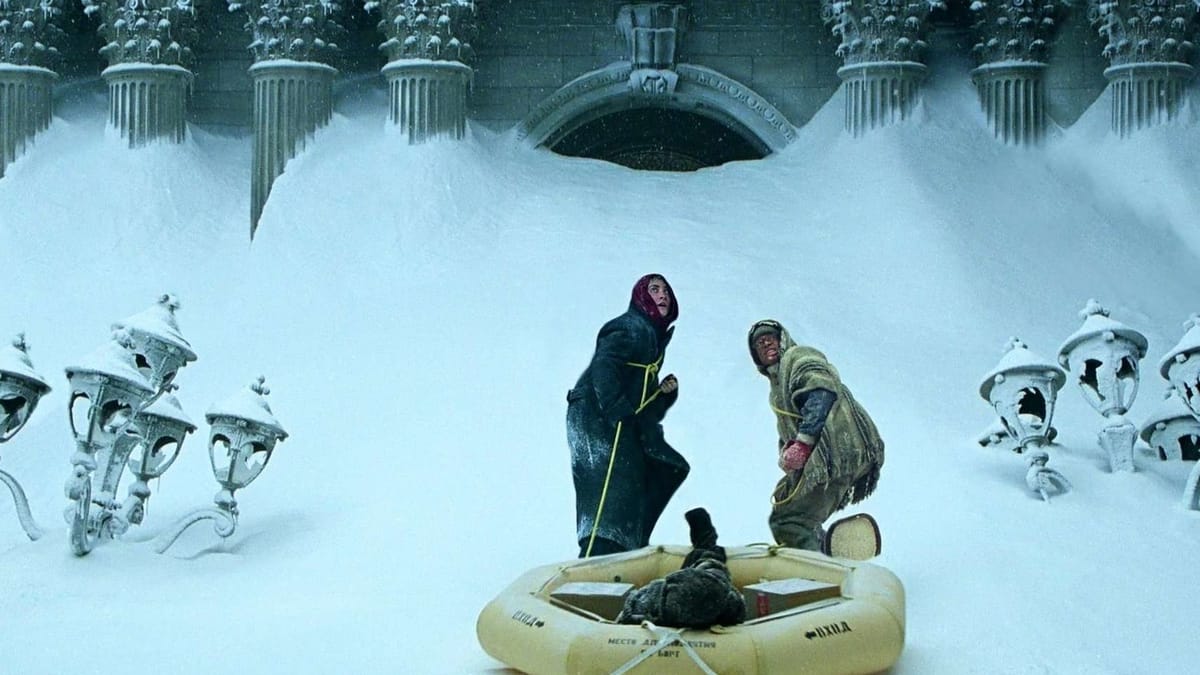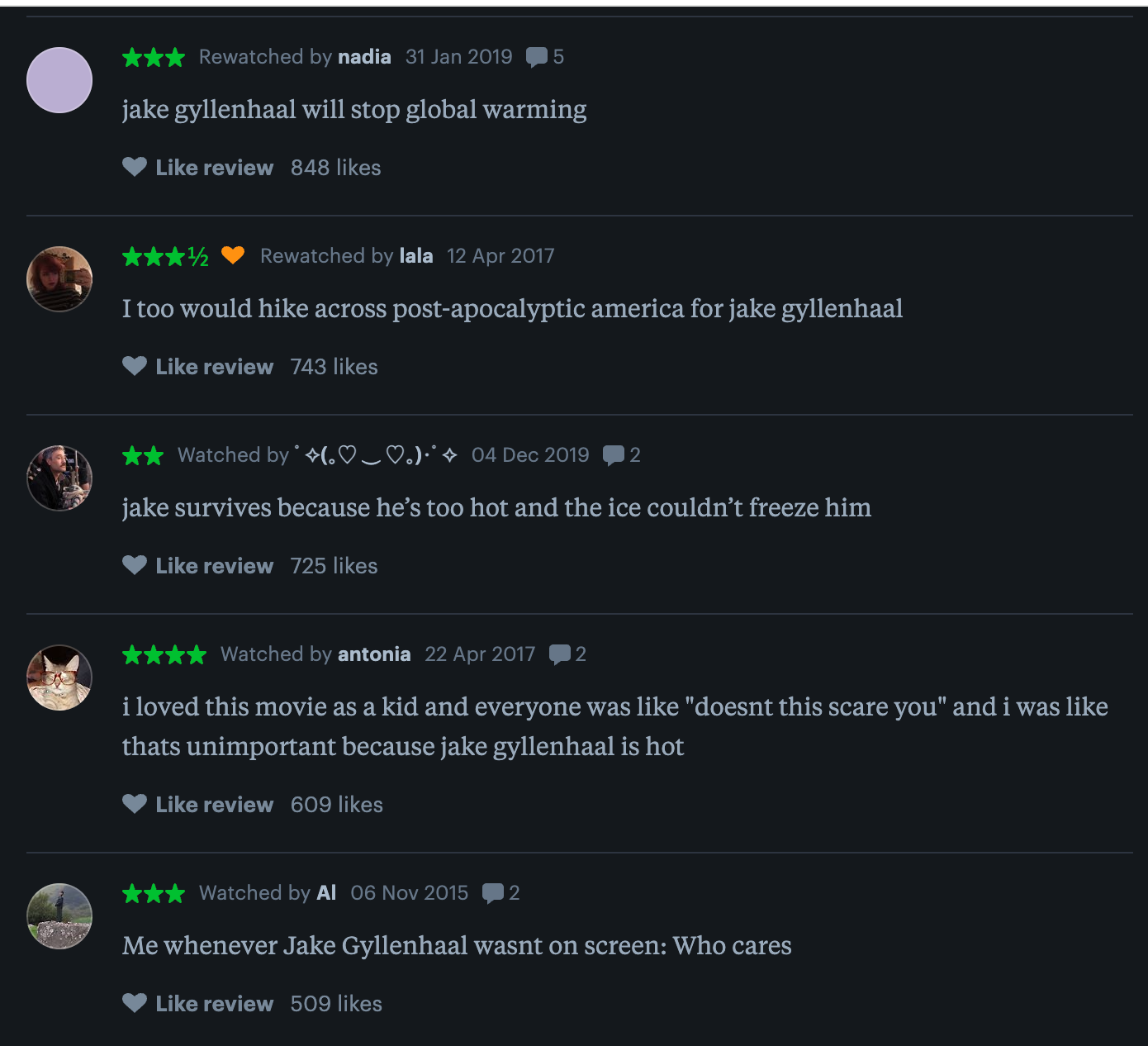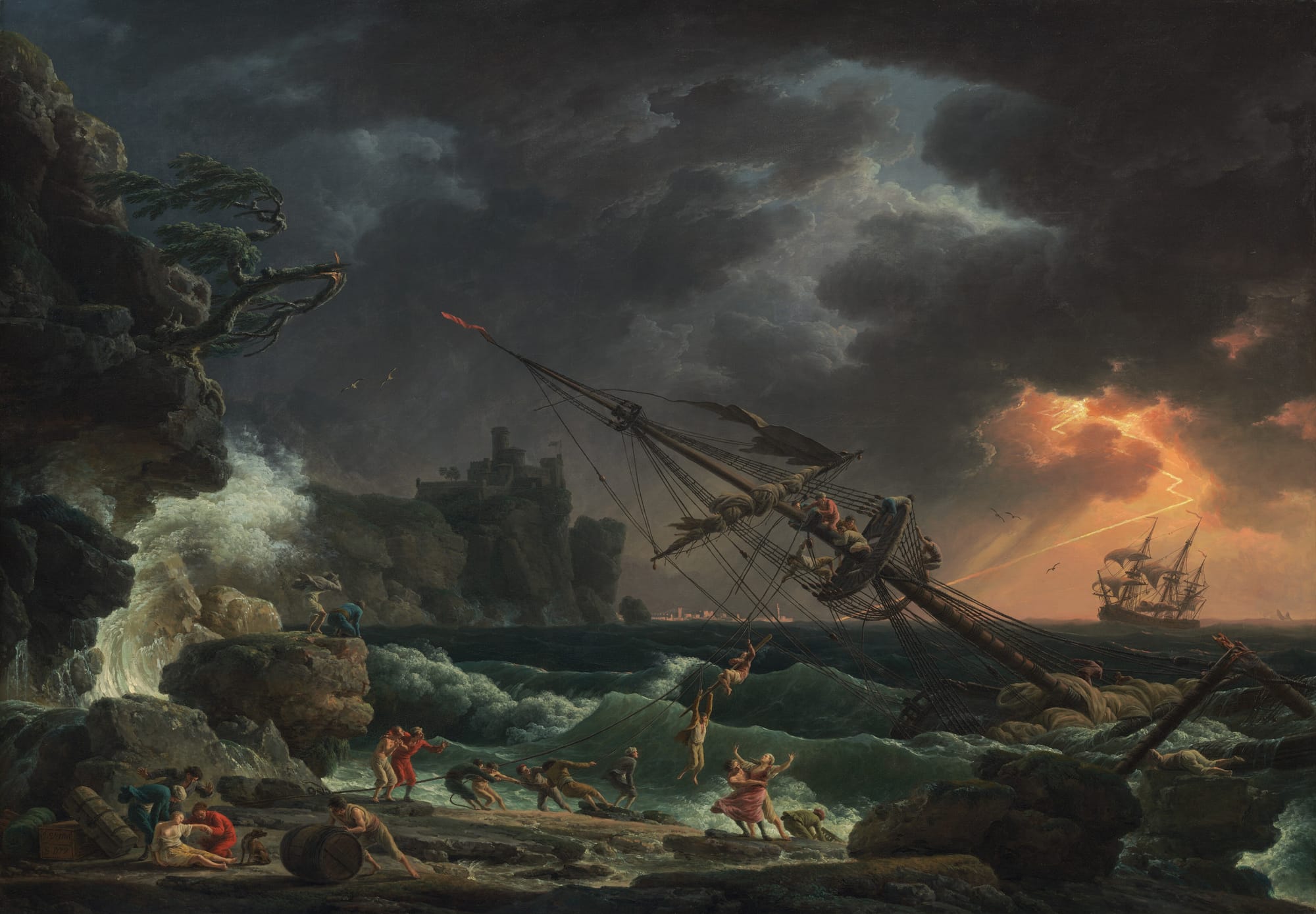A Mod-ICED SNOW-posal: The Day After Tomorrow (Roland Emmerich, 2004)
Starring Jake CHILL-enhaal. Okay, fine, I'll stop.

In the 19th century, people used to go see paintings of shipwrecks. This fact — which I learned in my one and only art history course, and which is, to this day, possibly the only thing I know about paintings — has always seemed, to me, like the best possible explanation for Roland Emmerich.
Bluntly: Emmerich blows stuff up. A lot. This does not make him unique: Michael Bay blows stuff up, too, and was equally popular during the same time period. Yet Emmerich blows things up on a cosmic, planetary, sometimes interplanetary scale. Michael Bay might blow up an asteroid, or a harbor, but in a Roland Emmerich movie, the action isn’t over until every major city on the globe, and most of the area in between, is one big smoking crater.
In Emmerich’s first big blow-up, Independence Day, the damage came from aliens conquering the earth, so it sort of made sense. In subsequent movies, it has made less sense, with the Earth being blown up by the year 2012 (2012), the Moon (Moonfall), and homophobia (Stonewall, also directed by Roland Emmerich).
Selecting a single example from the canon is hard — each has its own particular glories — but for our purposes, we’ll go with the one that has a threat slightly more plausible than aliens and slightly less plausible than homophobic cops: The Day After Tomorrow, a stirring tale of the Earth being destroyed by Global Warming.
Global Warming is, of course, portrayed as a giant hurricane-shaped freeze ray aimed at Earth, which can only be defeated by a distant, work-obsessed Dad (Dennis Quaid) reuniting with his quasi-estranged son (Jake Gyllenhaal) on the steps of the New York Public Library (demolished by a hurricane-shaped freeze ray). Our cast includes:
- Dennis Quaid!
- Jake Gyllenhaal!
- Dick Cheney!
- Flip phones!
- Ian Holm!
- The White Stripes!
- Air America Radio!
- Dr. Gregory House’s girlfriend from House, M.D.!
- A dog!
- A wise old homeless man who teaches people how to eat garbage!
- Custom LiveJournal avatars!
- “Mission Accomplished!”
- That guy from One Tree Hill!
- The Kyoto protocol!
- Dash Mihok!
- Too many shirts!
- “Metrosexuals!”
- A guy from 24!
Not featured: The laws of nature, which are routinely violated, beginning with the choice to cast a then-24-year-old Jake Gyllenhaal as a high school student. He had bulked and stubbled up considerably, since Donnie Darko, and for several minutes after his introduction, we viewers are left wondering where this supposed “child” is, and why Jake Gyllenhaal is playing a weird uncle crashing in his house.
It could have been worse; the character was originally supposed to be eleven. Yet, though Emmerich aged him up specifically so that Gyllenhaal could play the role — and though the plot revolves around him leaving to attend school in New York, something that (say) NYU students do — they have failed to make him a college student. Jake Gyllenhaal is older than I am, Reader, and in the year 2004, I was… well, I was not yet born, sadly. As an up-and-coming member of Gen Z, I have no memory of the early 2000s, but if I did, seeing Jake Gyllenhaal introduced as a child would no doubt make me laugh.

Having demolished linear time, and at least one glacier in the opening sequence, The Day After Tomorrow sets about smashing the ecosphere into its constituent parts, one major landmark at a time.
The World’s Most 35-Year-Old 17-Year-Old has a father, played by Dennis Quaid, and this father is a “paleoclimatologist” (sure) employed by the government (uh-huh) and locked in unceasing battle with Dick Cheney — who is, yes, given a different name, but who is very clearly just a lookalike playing George Bush’s power behind the throne, as evidenced by several scenes where he sneers evilly about the Kyoto protocol.
Audiences ate this shit up in 2004, by the way. Every third movie would model a villain on Dick Cheney, or refer to George Bush as “Shrub,” and we acclaimed each and every one of them as a masterful, Modest-Proposal-level social satire. This was our Chapo Trap House, and needless to say, it’s aged just as well.
This is the Halloween Special – you get 20% off your first 12 months if you sign up for a paid subscription.
In addition to our cheap-seats tier, we also boast the brand-new "Friend of the Blog" tier, which (at $9 per month and $99 for a year) gives you the comfort of knowing that I can pay my heating bill, and thus will not freeze to death in our New Ice Age.
At any rate: “You’ve got to listen to the SCIENCE,” Dennis Quaid grits manfully, in a movie containing no science whatsoever, and sure enough, Science descends to punish Dick Cheney, in the form of Global Warming. Softball-sized hail in Japan! Giant tornadoes in Los Angeles! A tidal wave flooding Manhattan! At one point, two people are making out, and one of them says, “shh! I hear something!” and so of course, her boyfriend gets up and goes to see where that suspicious noise is coming from. The suspicious noise is coming from GLOBAL GODDAMN WARMING, sneaking up on them both like Jason Voorhees.
Finally, Global Warming reveals its treacherous end game: Making everything much, much colder, via the aforementioned freeze-ray. Specifically, Global Warming is aiming freeze-rays at Jake Gyllenhaal, who is trapped in the New York Public Library with his would-be girlfriend, a few classmates, and a wise old homeless man who teaches him to eat garbage.

Being the son of a top paleoclimatologist, and also at least ten years older than anyone present, Jake Gyllenhaal is uniquely suited to lead humanity through this crisis. It is thanks to him that his schoolmates — who are (I remind you) trapped in a library that has had all its windows shattered, and its heat and electricity cut off, and which has been flooded by a tidal wave, then frozen to solid ice, then buried under a literal mountain of snow, then surrounded by wolves — manage to defeat the giant freeze-ray that instantly reduces temperatures to minus 200 degrees by… lighting a fire in the fireplace.
Of course! Fireplaces! Its greatest weakness! These are the things you don’t learn without a top paleoclimatologist around the house, let me tell you.
Meanwhile, Dick Cheney is forced to make the entire American population immigrate to Mexico to avoid the freeze ray. This is something of an ironic comment on “illegal immigration,” as you can tell by the newscaster saying, directly to the camera, that we are witnessing “a dramatic reversal of illegal immigration.” Again, this was devastating satire in 2004, and we loved it. We even forgave Emmerich for missing the obvious joke about white people fleeing ICE.
Somewhere in all this, Dennis Quaid decides to walk from Washington, D.C. to New York to save Jake Gyllenhaal, for, just as the all-powerful space hurricane that can instantly freeze internal combustion engines with the power of pure Cold is helpless before medium-sized indoor fireplaces, it is unable to defeat Dads Who Care. This leads to a tragic moment wherein Dennis Quaid finds out that he has been away from his son so long that he’s aged into a 40-year-old man with lower back problems and strong opinions on digital vs. physical media. But then he realizes that’s just what Jake Gyllenhaal looks like, and the human race — except for the roughly 33% of it that froze to death because they weren’t smart enough to think of “fireplaces” — is saved.
Back to the shipwreck paintings. You thought I’d forgotten them, hadn’t you? Well, I had, but there’s a lesson to be learned. Long-distance travel was done by ship, at the time, so a shipwreck was always on the horizon of real possibility — like your plane going down over the Atlantic, it wasn’t the most likely scenario, but everyone who went to see those paintings could recall a real wreck.

You were looking at your own death, but deferred, and frozen; the tree bending sideways in the storm gale, the capsizing ship, the illumination of lightning coming through the clouds like a glare from God’s eye. All those little bodies on the shore, struggling and falling and screaming at Heaven — which one would be you? Would you fight, would you drown?
Yet these were not necessarily gory paintings. There was a strange and severe beauty to them. Humans, famously, are the only animals that know we will die (if you don’t count elephants, which you probably should) and these paintings, with their still, silent, awe-full deaths, were a way to face that knowledge. They invited viewers to contemplate human powerlessness and mortality in a safely contained setting. Their grandeur drove home the point: Some things are just bigger than you. Sooner or later, something bigger than you will do you in.
Climate change was only a possibility in 2004. It was not yet here; it was still out on the horizon. Scientists still believed, back then, that concerted human activity could prevent it – we just hadn't gotten around to preventing it yet. In 2004, when we were not yet experiencing climate change, what people went to see was The Day After Tomorrow.
I mean: The movie was advertised with a countdown clock. Who has fun looking at a countdown clock if they expect it to hit zero? “I am sure global warming is real, and I regret that the Bush administration rejected the Kyoto Treaty, but I doubt that the cataclysm, if it comes, will come like this,” wrote Roger Ebert. “It makes for a fun movie, though. Especially the parts where Americans become illegal immigrants in Mexico[.]”
See? I told you! We loved that part! Twenty years later, though, we have long since counted down past zero. I’m pretty sure global warming killed my dog last summer. There was a long, bad heat wave, and she was old, and didn’t make it. I’m almost equally sure that the same heat wave killed my dad; he died a few days later, after the heat broke, but old people experiencing heart failure is a well-known side effect.
We know what climate change looks like now, and it’s not spectacular. It’s not an action sequence. It’s not a freeze ray. Climate change is just weather, like everything else, except it’s the kind of weather you don’t survive. There is a part of the shipwreck you won’t see in any painting, and it’s what comes after. Once all the screaming and sinking is over, it just looks gone.
The Day After Tomorrow is streaming on Disney+ and Hulu. Many thanks to Arnold Schwarzenegger as Mr. Freeze for punching up the puns.
I planned and wrote this month's content several weeks in advance, but it would be crass not to point out that there is a real, no-joke natural disaster, Hurricane Helene, currently unfolding on the East Coast, and another, Hurricane Milton, on the way. Climate change is, in fact, very real. Here, courtesy of Emily Mills, is a Google Doc of emergency relief and mutual aid groups to support for Helene survivors; I'll post similar information for Milton if and when I get it.
I debated whether to share this. I did apologize on the air. But I invite you to read my introspection on @BulletinAtomic of how extreme weather 📈 driven by global warming has changed me. Frankly, YOU should be shaken too, and demand #ClimateActionNow. https://t.co/09vxgabSmX https://t.co/GzQbDglsBG
— John Morales (@JohnMoralesTV) October 7, 2024